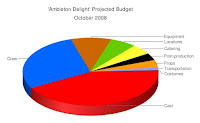 By Dan Parkes (Director/editor)
By Dan Parkes (Director/editor)It is a disturbing aspect of being a filmmaker, but unfortunately the not-so-simple act of making a film will automatically put you in line for possible
abuse, either directly, or more likely indirectly, (as with website 'trolls').
You may also think that this would more likely come from disgruntled and anonymous audiences who dislike the end product. The fact is that the four main sources of abuse will come from possibly surprising quarters:
fellow filmmakers.
Constructive criticismBefore looking at some specific examples we must emphasise the importance of constructive criticism and how this differs from insulting or attacking filmmakers or their films. There is a simple saying frequently used on film sets: "
Don't give me a problem, give me a solution". This shows how the following examples certainly differ from constructive criticism which should be warmly welcomed by all filmmakers. I personally encourage people to criticise and comment on my work and will take onboard such advice (refer to a recent blog about
test audiences here) especially when they give practical suggestions and solutions to what they think isn't working or could be done better.
However this is completely different from those who make unfounded, aggressive and in many cases just plain insulting comments. Their
intent is not to help the film or the filmmaker but -just the same as the proverbial school bully- to make themselves feel better by putting others down. Which is not only childish but a real shame to discover that such immature behaviour exists within an industry that thrives on teamwork. In many cases it stems from bitterness, jealously and issues that are more their own making and irrelevant to the filmmaker or film they are attacking.
1. From cast (the "prima donnas")We have already covered the fact that unfortunately there are actors who can suddenly turn abusive over imagined ill-treatment. Unlike the other three sources, this can be a particular problem for a low budget production if it requires recasting. For more information on dealing with prima donnas check
here.
2. From crewDuring the making of
Ambleton Delight the production team extended every effort to make cast and crew feel as comfortable and appreciated as possible -despite the fact that this can be a very difficult task when working on such a low budget.
The general response has been very positive. But we have heard stories from other film sets where this is not the case, with DoPs having to take over the role of the director due to a row with the cast, of crew storming off sets because they are bored or feel they are being 'used', of unpaid runners suing a production company, or those who just don't turn up at all. And then there are those who bad mouth the production team afterward, instead of raising the concerns at the time.
3. From volunteers We had an interesting situation where a man who had previously worked in the film business, kindly offered the rear of his restaurant premises for a shoot. He volunteered, without us even asking, an offer we eventually took up when we found ourselves in a tight spot. The location worked well, but due to failing light we asked if it was possible to come and film pickups. Unfortunately, one of the producers who made the telephone call obviously caught this man in a different mood, who became so abusive over the phone that it made any thought of shooting pickups completely impossible. We have no idea what changed his attitude, except that he possibly
assumed we actually had a larger budget than what he previously thought. This is in fact the key issue when receiving help from volunteers especially when you also have high professional standards -it can sometimes send the wrong message.
4. From fellow filmmakersAnd then the most surprising (or maybe not so surprising?) source: from those the same as you. You would think that the amount of effort involved in film production would garner at least a small amount of mutual respect. Apparently not.
Here are some 'printable' examples of what fellow filmmakers have written about our production and production blog....

Karel Bata a UK filmmaker (lives in a "posh bit" of London, http://sweetheartfilms.com/) was the first to take unreasonable offense by alleging our lighting blog recommended not using a DoP (which it did not) and went on to post on forums and bulletins insults and allegations such as "He's made a huge public gaff, and is now getting his head chewed off. He'll learn from it...complete IDIOT here."

Freya Black, a UK filmmaker also wrote about our lighting blog: "How nasty can you get!....making such a massive fool of themselves in public, I personally just find it embarrassing...will just make me cringe, even if it has high bizarre value....it certainly seems like you have been disloyal and unappreciative".

Mike Mann (http://www.gitve.com/team.html) also took exception to the lighting blog describing it as a "slap in the face to DPs disguised as a tip to the masses."

Fellow low budget filmmaker Jonathan Williams regards our production diary as "spam disguised as endless, and often substandard 'tips'... as a means of pulling them to your website and attempting to sell them your DVD".

Valentine Palmer, a Brighton, UK based actor/presenter most famous for some TV bit parts and for directing a porn film. "Your feature film (with a title too laughable to even mention)... within the first few minutes of the film’s showing, (I could see) that this was an absolute disaster.... you appear to be manifestly incapable of taking charge of the director’s chair for any kind of major filmic undertaking... The screenplay of your film gave the impression of having been written by someone who had never bothered to study the construction of a movie. There was no noticeable plot arc, character arc or scene arc. There was certainly no apparent 3-act structure within a film devoid of action, humour, suspense or romance."

Gregory Singer, Director at Stallion AV Productions in the Greater New York area and who describes himself as "proud to be Korean... shy around people, but not with a camera" began by describing the film as "Nice. Not great, but nice." But became increasingly unpleasant and over the course of many months posted many unfounded accusations on Shooting People bulletins including those that took "issue with" our production blog which he goes so far as to call "dangerous" and "disseminating bad information... Breaking the law is promoted as *good* low budget filmmaking technique...Unilaterally redefining decades old set job descriptions because 'having no money' makes you an exception?" He called us "newbies" and asked: "What exactly do you think DP or DoP stands for? DIRECTOR of Photography. Did you go through several MOVIE DIRECTORS when shooting this film? Is it a sort of Round Robin production where everybody gets a chance to do each job?"

UK filmmaker and blogger Ben Blaine (picture with brother Chris above) also entered the furor over our blog which he labelled "the Ambleton Delight Debacle" calling it "delicious bru-ha-ha... where a couple of badly chosen words about DPs have sparked a furore."

Dan Selakovich an editor/writer from LA, took exception to the blog on continuity, reading an unwritten job description inbetween the lines, saying "We are into my pet peeve of the view of script supervisor, and this low-budget tip has gotten it wrong... again....One more part of this "tip" that makes my blood boil...that's rank beginner stuff....What you leave out in your "tips" is blinding... More of my nasty comments below: I don't find your blogs practical. I find them utterly incomplete."

Someone who calls themselves "Anonymous" wrote this curious entry on the lighting blog "Dear Mr. Rambleton...you set yourself up for this....Very strange how I don't see more directors holding a boom. Seems to me you should take your 'advice' and go 'Australian'".

Tom Tremayne even questions our "creativity" when he writes: "It's a shame that supposedly creative people feel they need to impart advice that's merely common sense dressed up as something else!"
You might wonder why we have gone to the effort of reprinting what is mostly either unfounded, misconstrued or just plain insulting comments, especially since we have received several times more positive and appreciative feedback, not to mention even some awards. Well it just goes to show how as a passionate and heartfelt low budget filmmaker you will also need to
develop a thick skin and a
sense of humour, and especially don't expect any sympathy or even support from fellow filmmakers!
 By Dan Parkes (Director/editor)
By Dan Parkes (Director/editor)

















































